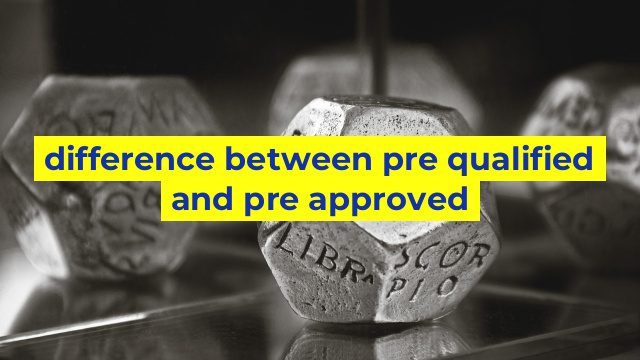Difference between Pre-Qualified and Pre-Approved
When you are looking to buy a new home, you will hear the terms pre-qualified and pre-approved mentioned quite often. Although these terms sound similar, they refer to two very different things. In this article, we will explore the differences between pre-qualified and pre-approved.
What is Pre-Qualification?
Pre-qualification is the initial step in the home buying process. It involves a lender reviewing your financial information to estimate how much you can afford to borrow. To get pre-qualified, you will provide the lender with some basic information about your income, debt, and assets. Based on this information, the lender will provide you with a rough estimate of how much you can borrow.
Pre-qualification is a good starting point for buyers who want to get a general idea of their purchasing power. However, it is important to note that pre-qualification is not a guarantee that you will be approved for a specific loan amount.
What is Pre-Approval?
Pre-approval is the next step in the home buying process. It involves a lender reviewing your financial information in greater detail to determine if you are eligible for a specific loan amount. To get pre-approved, you will need to provide the lender with documentation of your income, debt, and assets. The lender will then review your credit report and other financial information to determine your eligibility for a specific loan.
Pre-approval is a more in-depth process than pre-qualification. It requires a hard credit inquiry, which can temporarily lower your credit score. However, pre-approval provides a more accurate estimate of how much you can borrow and can make you a more competitive buyer in a competitive housing market.
What’s the Difference?
The primary difference between pre-qualification and pre-approval is the level of scrutiny given to your financial information. Pre-qualification provides a rough estimate of your borrowing power based on your self-reported income, debt, and assets. Pre-approval, on the other hand, requires verification of your financial information and a hard credit inquiry.
Another difference is that pre-qualification is a relatively quick process that can be completed online, while pre-approval can take several days or even weeks to complete. However, pre-approval provides a more accurate estimate of your borrowing power and can give you a competitive advantage when negotiating the purchase of a home.
The Bottom Line
Both pre-qualification and pre-approval are important steps in the home buying process. Pre-qualification is a good starting point to get a general idea of how much you can borrow, while pre-approval provides a more accurate estimate of your borrowing power. If you are serious about buying a home, getting pre-approved can give you a competitive edge in a competitive housing market.
Table difference between pre qualified and pre approved
| Pre-Qualified | Pre-Approved |
|---|---|
| Refers to an estimate of how much a borrower may be able to borrow based on their overall financial situation, such as income, debt, and credit score. | Refers to a written commitment from a lender stating the maximum amount they are willing to lend to a borrower, after a thorough analysis of their financial situation, such as income, debt, credit score, and employment history. |
| It is generally a quick and simple process that can be done online or over the phone, and does not require any documentation or verification. | It involves a more thorough review of the borrower’s financial documents and credit history, and may require documentation such as tax returns, pay stubs, and bank statements to verify the borrower’s financial situation. |
| It gives borrowers a general idea of their homebuying budget, but does not guarantee a loan approval. | It is a stronger indication that a borrower will be approved for a mortgage, as long as their financial situation does not change significantly before closing. |
| It can be helpful for borrowers to obtain before house hunting, to see what price range they can afford. | It gives borrowers more negotiating power when making an offer on a home, as they have already been pre-approved for a loan. |
